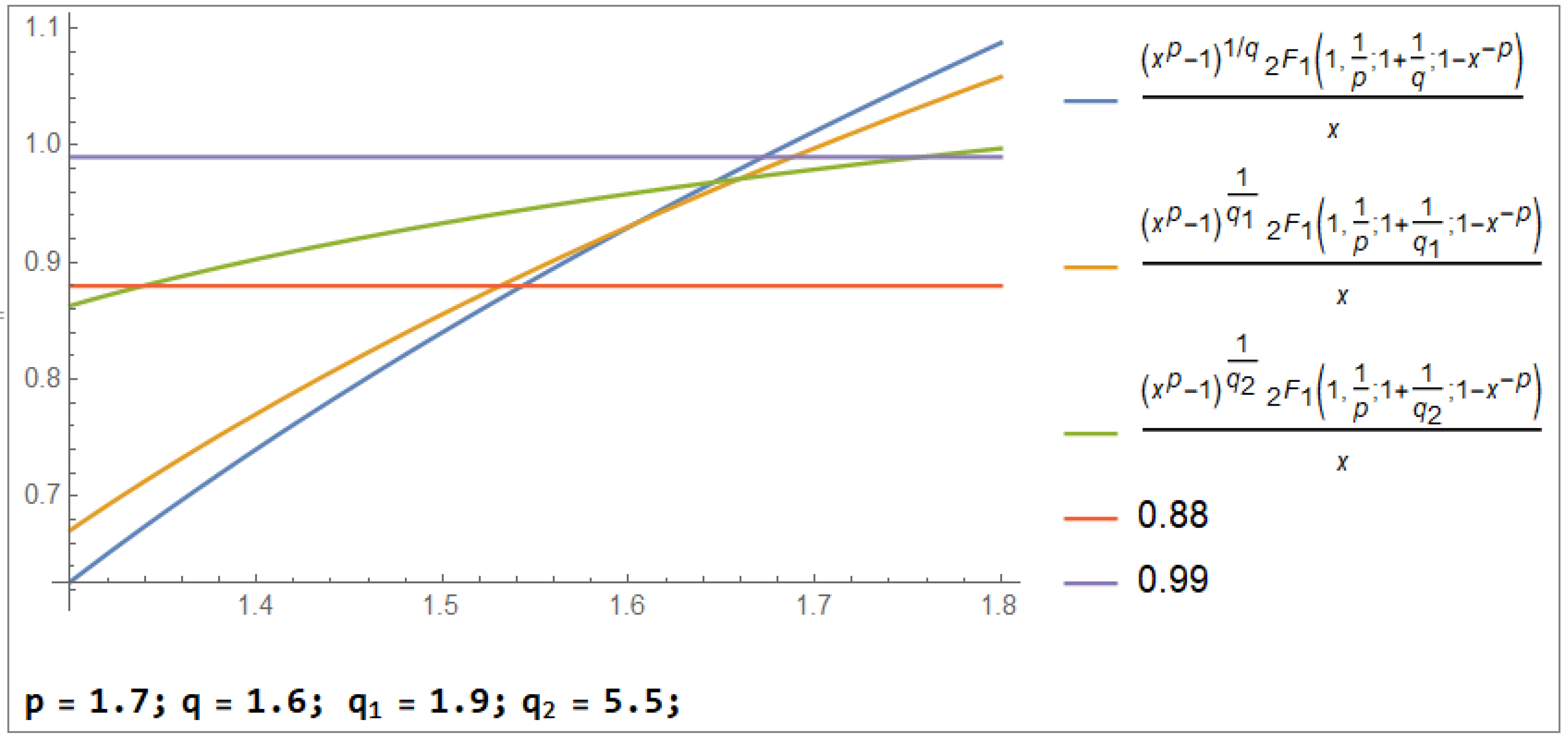A Look at Generalized Trigonometric Functions as Functions of Their Two Parameters and Further New Properties
Abstract
1. Introduction and Preliminaries
2. Monotonicity and Convexity in Parameters
3. Evaluation of Some Integrals
4. Conclusions
Author Contributions
Funding
Data Availability Statement
Conflicts of Interest
References and Note
- Lundberg, E. Om Hypergoniometriska Funktioner af Komplexa Variabla [On Hypergeometric Functions of Complex Variables], Stockholm, Sweden, 1879.
- Lang, J.; Edmunds, D.E. Eigenvalues, Embeddings and Generalised Trigonometric Functions. In Lecture Notes in Mathematics; Springer: Berlin/Heidelberg, Germany, 2011. [Google Scholar]
- Lindqvist, P. Some remarkable sine and cosine functions. Ricerche Mat. 1995, 44, 269–290. [Google Scholar]
- Lindqvist, P.; Peetre, J. P-arclength of the q-circle. Math. Student. 2003, 72, 139–145. [Google Scholar]
- Poodiack, R.D.; Wood, W.E. Squigonometry: The Study of Imperfect Circles. In Springer Undergraduate Mathematics Series; Springer: Berlin/Heidelberg, Germany, 2022. [Google Scholar]
- Ôtani, M. On certain second order ordinary differential equations associated with Sobolev-Poincare-type inequalities. Nonlinear Anal. Theory Methods Appl. 1984, 8, 1255–1270. [Google Scholar] [CrossRef]
- Drábek, P.; Manásevich, R. On the closed solution to some nonhomogeneous eigenvalue problems with p-Laplacian. Differ. Integral Equ. 1999, 12, 773–788. [Google Scholar] [CrossRef]
- Andrews, G.E.; Askey, R.; Roy, R. Special Functions; Cambridge University Press: Cambridge, UK, 1999. [Google Scholar]
- Edmunds, D.E.; Gurka, P.; Lang, J. Properties of generalized trigonometric functions. Approx. Theory. 2012, 164, 47–56. [Google Scholar] [CrossRef]
- Baricz, A.; Bhayo, B.A.; Klen, R. Convexity properties of generalized trigonometric and hyperbolic functions. Aequat. Math. 2015, 89, 473–484. [Google Scholar] [CrossRef]
- Miyakawa, H.; Takeuchi, S. Applications of a duality between generalized trigonometric and hyperbolic functions. J. Math. Anal. Appl. 2021, 502, 125241. [Google Scholar] [CrossRef]
- Miyakawa, H.; Takeuchi, S. Applications of a duality between generalized trigonometric and hyperbolic functions II. J. Math. Inequalities 2022, 16, 1571–1585. [Google Scholar] [CrossRef]
- Takeuchi, S. Multiple-angle formulas of generalized trigonometric functions with two parameters. J. Math. Anal. Appl. 2016, 444, 1000–1014. [Google Scholar] [CrossRef]
- Lindqvist, P.; Peetre, J. Comments on Erik Lundberg’s 1879 Thesis, Especially on the Work of Göran Dillner and His Infuence on Lundberg, Memorie dell (I.R.) Istituto Lombardo di Scienze e Lettere (ed Arti), Classe di Scienze Matematiche e Naturali; XXXI; Fasc. 1; Istituto Lombardo Accademia di Scienze e Lettere: Milano, Italy, 2004. [Google Scholar]
- Karp, D.B.; Prilepkina, E.G. Parameter convexity and concavity of generalized trigonometric functions. J. Math. Anal. Appl. 2015, 421, 370–382. [Google Scholar] [CrossRef]
- Kobayashi, H.; Takeuchi, S. Applications of generalized trigonometric functions with two parameters. Commun. Pure Appl. Anal. 2019, 18, 1509–1521. [Google Scholar] [CrossRef]
- Takeuchi, S. Applications of generalized trigonometric functions with two parameters II. Differ. Equ. Appl. 2019, 11, 563–575. [Google Scholar] [CrossRef]
- Yin, L.; Huang, L.-G.; Wang, Y.-L.; Lin, X.-L. A survey for generalized trigonometric and hyperbolic functions. J. Math. Inequalities 2019, 13, 833–854. [Google Scholar] [CrossRef]
- Bhayo, B.A.; Vuorinen, M. On generalized trigonometric functions with two parameters. J. Approx. Theory. 2012, 164, 1415–1426. [Google Scholar] [CrossRef]
- Baricz, A.; Bhayo, B.A.; Vuorinen, M.M. Turán type inequalities for generalized inverse trigonometric functions. Filomat 2015, 29, 303–313. [Google Scholar] [CrossRef]
- Boyd, S.; Vandenberghe, L. Convex Optimization, 7th Printing with Corrections; Cambridge University Press: Cambridge, UK, 2009. [Google Scholar]
- Pinelis, I. L’Hospital type rules for monotonicity. J. Inequalities Pure Appl. Math. 2006, 7, 40. [Google Scholar]
- Boulton, L.; Lord, G.J. Basis properties of the p,q-sine functions. Proc. R. Soc. A 2015, 471, 20140642. [Google Scholar] [CrossRef] [PubMed]
- Dubey, S.R.; Singh, S.K.; Chaudhuri, B.B. Activation functions in deep learning: A comprehensive survey and benchmark. Neurocomputing 2022, 503, 92–108. [Google Scholar] [CrossRef]

Disclaimer/Publisher’s Note: The statements, opinions and data contained in all publications are solely those of the individual author(s) and contributor(s) and not of MDPI and/or the editor(s). MDPI and/or the editor(s) disclaim responsibility for any injury to people or property resulting from any ideas, methods, instructions or products referred to in the content. |
© 2024 by the authors. Licensee MDPI, Basel, Switzerland. This article is an open access article distributed under the terms and conditions of the Creative Commons Attribution (CC BY) license (https://creativecommons.org/licenses/by/4.0/).
Share and Cite
Karp, D.; Prilepkina, E. A Look at Generalized Trigonometric Functions as Functions of Their Two Parameters and Further New Properties. Mathematics 2024, 12, 3383. https://doi.org/10.3390/math12213383
Karp D, Prilepkina E. A Look at Generalized Trigonometric Functions as Functions of Their Two Parameters and Further New Properties. Mathematics. 2024; 12(21):3383. https://doi.org/10.3390/math12213383
Chicago/Turabian StyleKarp, Dmitrii, and Elena Prilepkina. 2024. "A Look at Generalized Trigonometric Functions as Functions of Their Two Parameters and Further New Properties" Mathematics 12, no. 21: 3383. https://doi.org/10.3390/math12213383
APA StyleKarp, D., & Prilepkina, E. (2024). A Look at Generalized Trigonometric Functions as Functions of Their Two Parameters and Further New Properties. Mathematics, 12(21), 3383. https://doi.org/10.3390/math12213383





